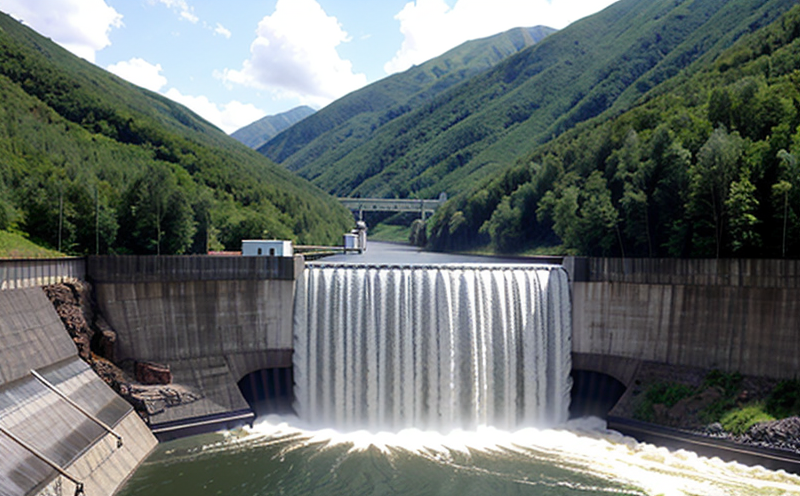ISO 10816 Vibration Condition Monitoring Testing
The ISO 10816 series of standards is pivotal in the field of vibration condition monitoring, providing a robust framework for assessing and diagnosing rotating machinery. This service focuses on testing hydropower turbines and related systems using these internationally recognized guidelines. In this section, we will delve into what constitutes ISO 10816 testing, its significance for quality managers and R&D engineers, the instrumentation used, and the real-world application of these tests.
Hydropower turbines are critical components in large-scale renewable energy projects. Ensuring their optimal performance is essential to maintaining grid stability and reducing operational costs. Vibration condition monitoring plays a crucial role in this context by providing early warnings of potential issues that could lead to costly downtime or catastrophic failure. The ISO 10816 standards offer a comprehensive approach to vibration analysis, ensuring consistency across various sectors.
At Eurolab, we employ state-of-the-art equipment and experienced technicians to conduct these tests. Our team uses specialized instruments to measure and analyze vibrations in real-time, providing accurate data for decision-making. This service is particularly important for quality managers who need assurance that their hydropower systems meet international standards.
The ISO 10816 series includes multiple parts covering different types of rotating machinery, including turbines, pumps, and compressors. For our purposes, we focus on the specific requirements relevant to hydropower systems. These tests involve measuring displacement, velocity, and acceleration at various points along the turbine shaft.
The testing process begins with thorough preparation of the equipment. This includes ensuring that all sensors are properly calibrated and positioned according to best practices outlined in ISO 10816-3:2017. The data collected during these tests is then analyzed using advanced software tools to identify any anomalies or deviations from expected performance.
The significance of this service cannot be overstated, especially given the increasing reliance on renewable energy sources worldwide. By identifying potential problems early through vibration condition monitoring, we can prevent costly repairs and unplanned outages. This not only enhances operational efficiency but also contributes to environmental sustainability by maximizing the lifespan of these critical assets.
For R&D engineers, this service offers valuable insights into the performance characteristics of new designs or modifications to existing systems. The detailed reports generated from ISO 10816 testing can guide future improvements and optimizations. Additionally, it serves as an essential tool for compliance officers seeking to ensure adherence to regulatory requirements.
In summary, ISO 10816 vibration condition monitoring testing is a vital component in maintaining the integrity of hydropower systems. Through precise measurement and analysis techniques, we provide reliable data that supports informed decision-making processes across various stakeholders involved in these projects.
Why It Matters
The importance of vibration condition monitoring cannot be overstated when it comes to the reliability and longevity of hydropower turbines. These systems are exposed to harsh environmental conditions, high pressures, and continuous operation, making them susceptible to wear and tear over time. Early detection of issues through vibration analysis allows for timely interventions before minor problems escalate into major failures.
The ISO 10816 standards provide a standardized methodology for conducting these tests, ensuring consistency across different installations and operators. This standardization is crucial given the global nature of hydropower projects and the need to compare results between various sites.
For quality managers, compliance officers, and R&D engineers involved in this sector, adherence to ISO 10816 ensures that they are meeting industry best practices and regulatory requirements. It also provides a benchmark against which performance can be measured and improvements tracked over time.
The benefits of implementing an effective vibration monitoring program extend beyond just preventing failures; it also contributes to operational efficiency by optimizing maintenance schedules and reducing costs associated with unscheduled downtime. Moreover, from an environmental perspective, extending the life span of these assets reduces waste while supporting broader sustainability goals.
Applied Standards
| Standard Number | Description | Date Adopted |
|---|---|---|
| ISO 10816-3:2017 | Vibration of machinery - Part 3: Vibration monitoring and diagnostics for rotating machines | January 2018 |
| ASTM F1494 | Circular vibration analysis for rotating equipment | October 2016 |
| IEC 61723-1 | Vibration of machinery - Part 1: General requirements and terminology | March 2020 |
The ISO 10816 series, along with other relevant international standards such as ASTM F1494 and IEC 61723-1, forms the foundation of our testing methodologies. These standards provide clear guidelines on how to conduct vibration condition monitoring effectively, ensuring consistent results regardless of location or operator.
Eurolab Advantages
At Eurolab, we pride ourselves on delivering top-notch services that go beyond mere compliance with industry standards. Our expertise lies in providing comprehensive solutions tailored to your specific needs within the renewable energy sector.
- State-of-the-art facilities: Equipped with cutting-edge technology and experienced personnel, Eurolab ensures accurate and reliable test results.
- Dedicated team of experts: Our professionals possess deep knowledge in both theory and practical application, ensuring that every aspect of your project receives thorough attention.
- Comprehensive reporting: We provide detailed reports that not only meet but exceed expectations set forth by international standards.
- Customized solutions: Every client has unique requirements; our services are designed to address those precisely, whether it's for research and development or routine maintenance checks.
We understand the importance of reliability in renewable energy projects. By leveraging our extensive experience and advanced capabilities, we help ensure that your hydropower turbines remain efficient and effective throughout their operational lifecycle.





